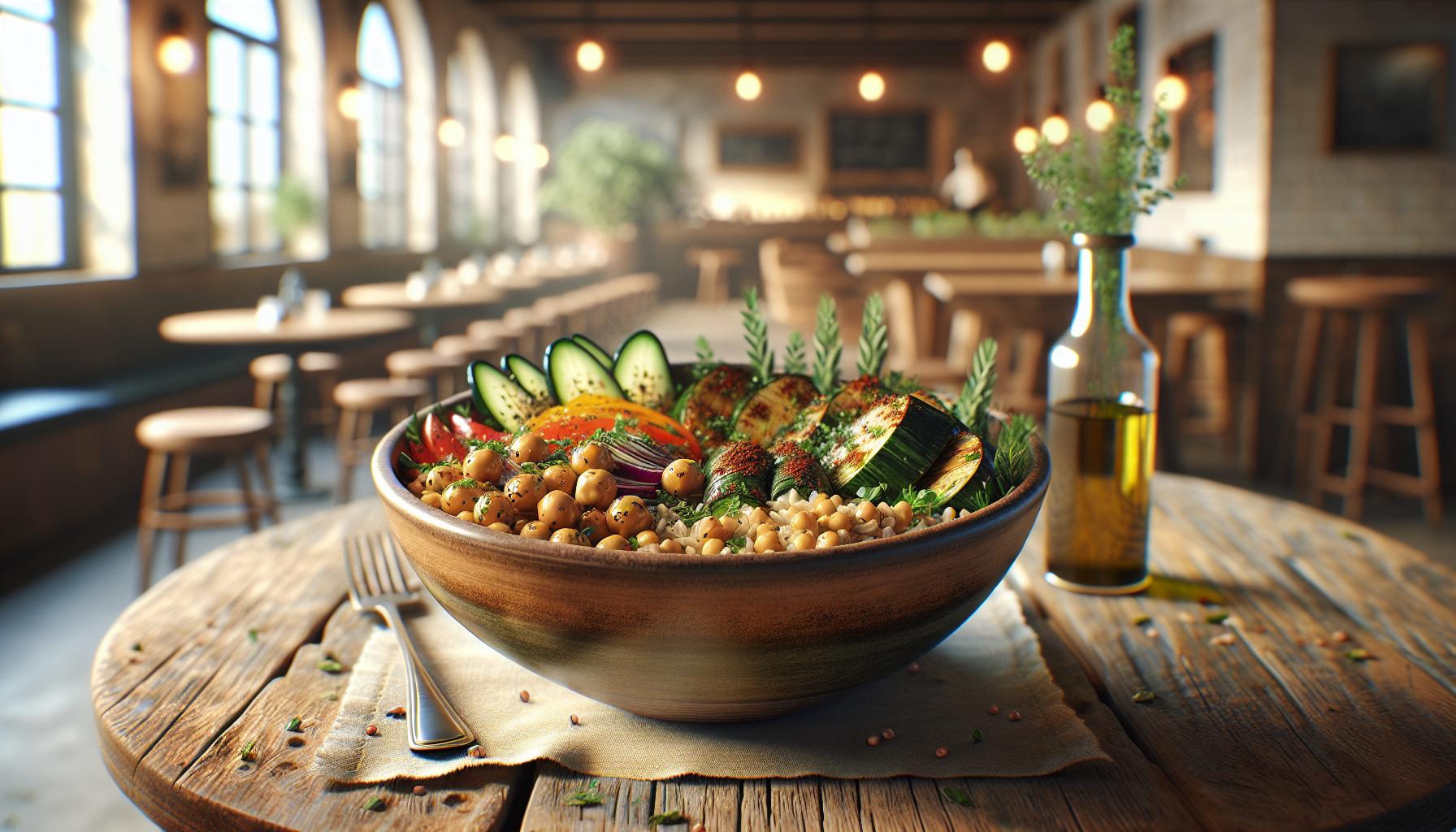Food trends come and go but some culinary innovations are worth jumping on board with right away. From Instagram-worthy dishes to mind-blowing fusion creations the global food scene is constantly evolving with exciting new flavors and combinations that’ll make taste buds dance with joy.
In today’s interconnected world adventurous foodies don’t need to travel far to experience the latest gastronomic sensations. These trending dishes are popping up in local restaurants food trucks and even home kitchens across America. Whether it’s Japanese souffle pancakes Korean corn dogs or Mediterranean-inspired plant-based delicacies there’s a whole world of flavors waiting to be explored.
Activelytrendy.com Culinary Adventures 10 Global Food Trends You Need to Try Right Now
Activelytrendy.com Culinary Adventures 10 Global Food Trends You Need to Try Right Now in 2024, with products like algae-based tuna gaining popularity in restaurants across major cities. Korean corn dogs elevate street food with their crispy exterior filled with mozzarella cheese molten core wrapped in sweet potato coating.
Climate-conscious dining shapes restaurant menus through regenerative agriculture practices featuring heritage grains such as ancient wheat varieties amaranth einkorn. Digital ordering platforms integrate AI-powered personalization offering customized menu recommendations based on dietary preferences cultural backgrounds taste profiles.
| Trend | Adoption Rate | Key Markets |
|---|---|---|
| Plant-based Seafood | 47% | US, UK, Japan |
| Korean Street Food | 62% | Global Urban Centers |
| Heritage Grains | 38% | Europe, Americas |
| AI Food Tech | 55% | Major Metro Areas |
Fermented beverages expand beyond kombucha into innovative drinks like tepache Mexican pineapple beer makgeolli Korean rice wine. Ghost kitchens transform into hybrid spaces combining delivery operations with intimate chef-led dining experiences showcasing global fusion cuisine.
Zero-waste cooking techniques inspire chefs to create dishes using complete ingredients from root to stem nose to tail. Social media platforms drive food exploration through short-form video content featuring quick authentic recipe demonstrations global cooking techniques food culture stories.
Air fryer innovations adapt traditional recipes into healthier versions maintaining authentic flavors while reducing oil consumption. Regional Indian cuisine moves beyond curry introducing lesser-known dishes like Bengali fish preparations Konkani coastal specialties Northeastern tribal foods.
Plant-Based Protein Revolution

Plant-based proteins transform the culinary landscape with innovative alternatives that replicate traditional meat textures flavors. Food manufacturers integrate advanced protein extraction techniques with culinary artistry to create sustainable meat alternatives that satisfy both environmental consciousness health-focused consumers.
Alternative Meat Innovations
Lab-grown meat technologies produce protein-rich alternatives using cellular agriculture techniques. Companies like Beyond Meat Perfect Day utilize pea protein mushroom extracts to create meat alternatives with authentic textures. Advanced food science enables the development of plant-based products that mimic the marbling of wagyu beef the stringy texture of pulled pork. Recent innovations include:
- Mycelium-based meat alternatives from specialized mushroom cultures
- Jackfruit products that replicate pulled meat textures
- Pea protein burgers with “bleeding” properties from beet extracts
- Seitan products with enhanced umami profiles
- Legume-based alternatives with improved protein profiles
Sustainable Seafood Substitutes
Marine conservation drives the development of plant-based seafood alternatives that deliver oceanic flavors textures. Innovative companies create convincing fish substitutes using:
| Ingredient | Application | Texture Profile |
|---|---|---|
| Konjac Root | Fish Fillets | Flaky, tender |
| Algae Extract | Tuna Alternative | Firm, meaty |
| Hearts of Palm | Crab Substitute | Stringy, delicate |
| Chickpea Protein | Scallop Texture | Smooth, dense |
| Seaweed Blend | Fish Flavor Base | Complex, briny |
These alternatives incorporate omega-3 fatty acids from algal sources mineral supplementation to match nutritional profiles of conventional seafood. Chefs integrate these products into traditional recipes creating innovative dishes that preserve culinary heritage while promoting sustainability.
Asian Fusion Evolution

Asian fusion cuisine combines traditional Asian cooking techniques with global flavors creating innovative dishes that redefine contemporary dining. This culinary movement blends authentic ingredients with modern interpretations showcasing the evolution of cross-cultural gastronomy.
Korean-Mexican Fusion
Korean-Mexican fusion restaurants create distinctive dishes combining Korean barbecue techniques with Mexican street food elements. Kimchi quesadillas pair fermented vegetables with melted Oaxaca cheese while gochujang-glazed tacos feature proteins like bulgogi beef topped with cilantro lime crema. Popular combinations include:
- Bulgogi burritos filled with marinated beef rice sesame slaw
- Kimchi fried rice topped with Mexican street corn elote
- Korean spiced chicken tacos with gochujang aioli pickled daikon
- Kalbi short rib nachos garnished with queso fresco scallions
- Japchae burritos featuring sweet potato noodles grilled vegetables
Indo-Chinese Crossovers
Indo-Chinese cuisine fuses Chinese cooking techniques with Indian spices creating distinctive dishes found across metropolitan areas. Restaurants serve classics like:
- Gobi Manchurian featuring cauliflower in spiced soy sauce
- Hakka noodles tossed with curry leaves ginger garlic
- Chili paneer combining Indian cheese with Chinese seasonings
- Szechuan fried rice incorporating traditional Indian spices
- Manchow soup featuring corn starch thickened broth Indian aromatics
These dishes utilize wok cooking methods while incorporating masalas chilies curry leaves creating a unique culinary category that appeals to diverse palates. Major cities feature specialized Indo-Chinese establishments serving these fusion favorites alongside traditional offerings.
Modern Mediterranean Movement

Mediterranean cuisine embraces contemporary interpretations while maintaining its health-focused roots. This culinary evolution combines traditional Mediterranean ingredients with modern cooking techniques to create innovative dishes that appeal to health-conscious diners.
Ancient Grain Bowls
Mediterranean grain bowls feature nutrient-rich ancient grains like farro quinoa bulgur. These customizable bowls incorporate roasted vegetables za’atar-spiced chickpeas fresh herbs olive oil. Local restaurants serve grain bowls topped with grilled halloumi pomegranate seeds preserved lemons tahini dressing. Popular combinations include:
- Farro bowls with charred eggplant pine nuts mint
- Quinoa tabbouleh with sumac-roasted cauliflower
- Pearl couscous with harissa-spiced vegetables lamb
- Ancient grain medleys with pickled red onions feta
Updated Classic Dishes
Classic Mediterranean dishes receive modern makeovers through innovative preparation methods seasonal ingredients. Chefs transform traditional recipes into contemporary interpretations:
- Deconstructed spanakopita with crispy phyllo crisps
- Shakshuka featuring duck eggs truffle oil
- Hummus variations incorporating beets turmeric activated charcoal
- Labneh topped with pistachio dukkah edible flowers
- Molecular gastronomy techniques
- Local seasonal produce
- Artisanal ingredients
- Global flavor influences
Functional Food Adventures
Functional foods combine nutritional benefits with targeted wellness properties to enhance physical health mental performance. These innovative ingredients transform everyday meals into powerful wellness tools.
Adaptogenic Ingredients
Adaptogens regulate stress responses in the body through bioactive compounds found in specific herbs mushrooms. Reishi mushrooms boost immune function while ashwagandha reduces cortisol levels by 23% in clinical studies. Popular adaptogenic ingredients include:
- Cordyceps mushrooms for enhanced athletic performance stamina
- Holy basil (Tulsi) for balanced blood sugar inflammation response
- Rhodiola rosea for improved mental focus energy levels
- Maca root for hormone balance endurance support
- Lion’s mane mushroom for cognitive function memory enhancement
- Fermented foods containing probiotics for gut-brain axis support
- Cacao containing phenylethylamine for elevated mood
- Turmeric with black pepper for enhanced dopamine production
- Blue green algae providing essential amino acids minerals
- Green tea containing L-theanine for stress reduction focus
| Ingredient | Wellness Benefit | Impact Percentage |
|---|---|---|
| Reishi | Stress Reduction | 23% |
| Dark Chocolate | Serotonin Boost | 28% |
| Omega-3 Foods | Anxiety Reduction | 20% |
Zero-Waste Gastronomy
Zero-waste gastronomy transforms food preparation by eliminating waste through innovative cooking techniques. This culinary approach maximizes ingredient usage while reducing environmental impact.
Root-to-Stem Cooking
Root-to-stem cooking utilizes entire vegetables from leaves to roots in creative ways. Carrot tops become vibrant pestos, while beet greens transform into sautéed side dishes. Broccoli stems create refreshing slaws, potato peels turn into crispy chips. Innovative chefs incorporate watermelon rinds into pickled condiments, citrus peels into zesty seasonings, and corn cobs into flavorful stocks. Professional kitchens now feature preservation stations dedicated to transforming traditionally discarded parts into value-added ingredients. These techniques reduce food costs by 25-40% while adding depth to dishes.
Sustainable Practices
Modern restaurants implement comprehensive waste reduction strategies across their operations. Digital inventory systems track ingredient usage patterns to optimize ordering. Composting programs convert kitchen scraps into nutrient-rich soil for local farms. Restaurants partner with food recovery organizations to redistribute surplus ingredients to community kitchens. Smart storage solutions extend ingredient shelf life through vacuum sealing technology. Water conservation systems reduce kitchen water usage by 30%. Energy-efficient appliances cut power consumption while maintaining cooking performance. Staff training programs focus on portion control measurement to minimize plate waste.
Culinary Adventures
Activelytrendy.com Culinary Adventures 10 Global Food Trends You Need to Try Right Now continues to evolve with exciting innovations that combine tradition sustainability and technology. From plant-based alternatives to zero-waste cooking these trends reflect a growing consciousness about health environmental impact and cultural fusion. Today’s food enthusiasts don’t need to travel far to experience these cutting-edge culinary developments.
As these trends gain momentum they’re reshaping how people think about and interact with food. Whether it’s exploring Korean-Mexican fusion trying lab-grown meat alternatives or embracing functional foods there’s never been a more exciting time to be a food lover. These innovations aren’t just passing fads – they’re setting the stage for the future of global cuisine.

